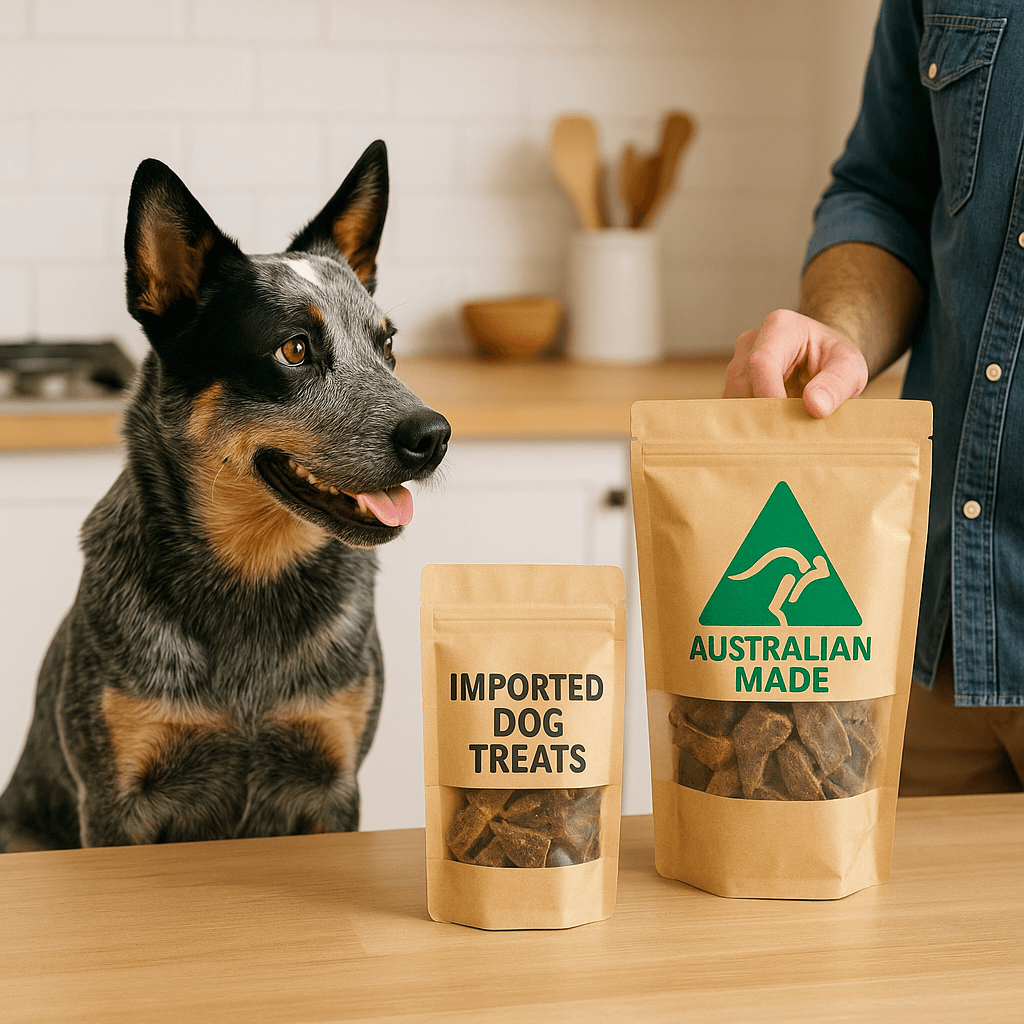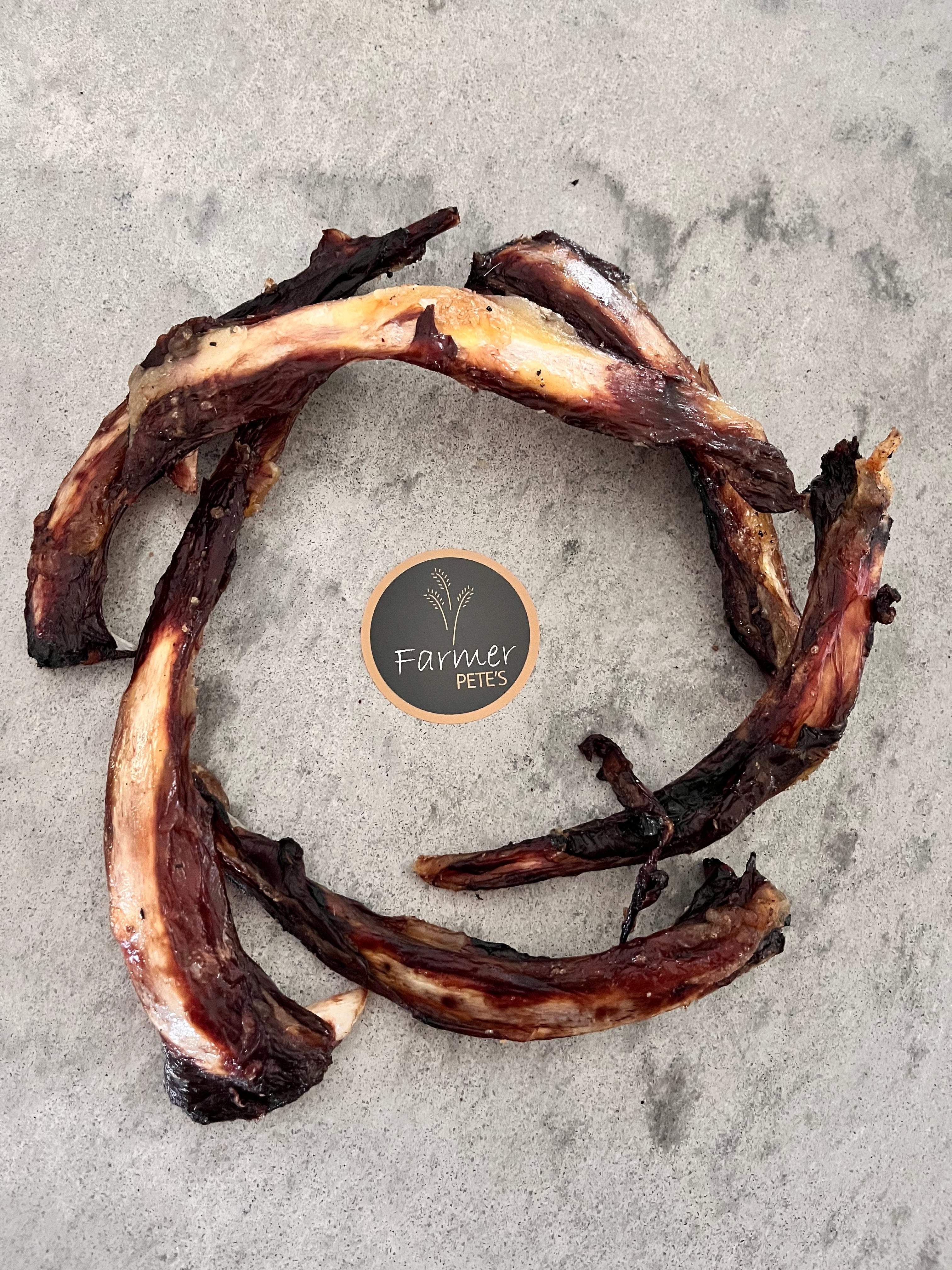Glycerin is a humectant, which means it attracts moisture. That's why it's used in human dry skin products – because it helps trap moisture in the skin. This also makes it useful in pet foods because it helps give food a moist, chewy texture while preventing it from drying out or getting mouldy.
Glycerin is a common ingredient in many dog treats and foods. It's a sugar alcohol derived from natural fats and oils, often used as a sweetener, preservative, or thickening agent in pet products. Here's a rundown of its characteristics, uses, and potential concerns:
The Good - Glycerin Benefits
Source: Glycerin can be derived from animal fats, plant oils (such as palm or coconut oil), or synthesised chemically.
Animal-Derived Glycerin
This type of glycerin is obtained from animal fats, such as tallow or lard. While it's a common source, some pet owners prefer to avoid it due to ethical concerns or dietary preferences, especially if they follow a vegetarian or vegan lifestyle.
Plant-Derived Glycerin
Glycerin can also be derived from plant sources like palm oil, coconut oil, or soybean oil. Plant-derived glycerin is often preferred by pet owners seeking products with sustainable and environmentally friendly ingredients. Additionally, it may align better with specific dietary restrictions or preferences.
Sweetening Agent
Glycerin's sweet taste makes it an attractive ingredient for pet treats, encouraging dogs to consume them eagerly. However, it's essential to balance sweetness with other nutritional considerations to ensure treats contribute positively to a dog's diet without excessive sugar content.
Humectant
Glycerin has hygroscopic properties, meaning it attracts and retains moisture. In pet treats, it helps maintain moisture levels, preventing them from becoming dry and stale. This is particularly beneficial for treats with a chewy or semi-moist texture, as it keeps them palatable and enjoyable for dogs over time.
Preservative
By inhibiting the growth of bacteria and mould, glycerin plays a role in extending the shelf life of dog treats. This helps maintain product freshness and safety, reducing the risk of spoilage and ensuring that treats remain wholesome from production to consumption.
Texture Enhancer
Glycerin contributes to the texture of dog treats, influencing their chewiness, or softness. Treat manufacturers carefully balance glycerin levels to achieve the desired texture that appeals to dogs while also ensuring ease of handling and packaging.
The Bad - Glycerin Concerns
Digestibility
While glycerin is generally well-tolerated by dogs, excessive consumption may lead to digestive issues such as diarrhea or vomiting. Some dogs may be more sensitive to glycerin than others, emphasising the importance of moderation and monitoring when introducing glycerin-containing treats.
Source
The source of glycerin can vary, and pet owners may prefer treats that use plant-derived glycerin over animal-derived ones for ethical or dietary reasons.
Quality
The quality of glycerin used in dog treats can vary depending on its source and processing methods. High-quality, food-grade glycerin undergoes strict quality control measures to ensure purity and safety, whereas Industrial lower-grade glycerin may contain impurities that could potentially pose health risks to pets.
Regulations
Regulatory agencies may impose standards and guidelines for the use of glycerin in pet products to safeguard animal health and welfare. Compliance with these regulations helps ensure that glycerin-containing treats meet established safety and quality criteria, providing pet owners with confidence in the products they choose for their furry companions.
The Ugly - Side Effects To Dogs
While glycerin is generally regarded as safe for dogs when consumed in moderation, excessive intake can lead to various side effects, especially gastrointestinal issues. Here are some potential side effects to consider:
Digestive Upset
One of the most common side effects of excessive glycerin consumption in dogs is digestive upset. This may manifest as diarrhoea, vomiting, or excessive gas. Dogs with sensitive stomachs or underlying gastrointestinal conditions may be more prone to these issues.
Dehydration
Glycerin's hygroscopic properties, which allow it to attract and retain moisture, can potentially lead to dehydration if consumed in large quantities without adequate water intake. This is particularly true for treats with high glycerin content, as they may draw water from the body during digestion.
Hyperglycaemia (High Blood Sugar)
While glycerin itself is not a sugar, it can be metabolised into glucose in the body. Excessive intake of glycerin-rich treats, especially in dogs with diabetes or insulin resistance, can contribute to spikes in blood sugar levels, leading to hyperglycaemia.
Weight Gain
Glycerin-containing treats may be high in calories, particularly if they also contain other ingredients like fats or carbohydrates. Overfeeding these treats can contribute to weight gain in dogs, leading to obesity and associated health issues such as joint problems and decreased mobility.
Pancreatitis
In some cases, high-fat treats containing glycerin may trigger pancreatitis, an inflammation of the pancreas. Dogs predisposed to pancreatitis, such as those with a history of the condition or certain breeds, may be more susceptible to this risk.
Dental Problems
Chewy treats with glycerin may stick to the teeth, promoting the build-up of plaque and tartar. Over time, this can lead to dental problems such as tooth decay, gum disease, and bad breath if proper dental care is not maintained.
Allergic Reactions
While rare, some dogs may have allergic reactions to glycerin or other ingredients in treats. Symptoms of an allergic reaction may include itching, hives, swelling, or difficulty breathing. If your dog displays any signs of an allergic reaction, discontinue the treats immediately and consult a veterinarian.

How can I tell if Glycerin is in a pet treat?
Identifying whether glycerin is an ingredient in a dog treat involves examining the treat's ingredient list. Here are some tips to help you determine if glycerin is present:
Read the Ingredient List
Look for glycerin listed among the ingredients. It may be listed as "glycerin," "glycerol," or its E number (E422). Ingredient lists are typically found on the packaging of the treat.
Check for Synonyms
Manufacturers may use alternative terms for glycerin, such as "vegetable glycerin" or "glycerine." Be aware of these variations when scanning ingredient lists.
Look for a Description or Purpose
Sometimes, the ingredient list will provide additional information about the purpose of glycerin in the treat, such as a humectant, sweetener, or preservative.
Position in the List
Ingredients are usually listed in descending order of predominance by weight. If glycerin is listed near the beginning of the ingredient list, it indicates that the treat contains a significant amount of glycerin.
Consider Treat Type
Glycerin is more commonly found in certain types of treats, such as chewy or semi-moist treats, where it helps maintain moisture and texture. Treats labelled as "soft," "chewy," or "moist" may be more likely to contain glycerin.
Research the Brand
Some pet food companies such as Farmer Pete’s have a commitment to transparency and provide detailed information about their ingredients and sourcing practices on their websites or product packaging. Checking the manufacturer's website or contacting them directly can provide additional insight into the use of glycerin in their treats.
Is glycerin used to extend the shelf life of pet treats?
Yes, glycerin is often used in dog treats to extend their shelf life. As a humectant, glycerin helps retain moisture. Additionally, glycerin has mild preservative properties. While it's not a strong preservative like synthetic additives such as BHA (butylated hydroxy anisole) or BHT (butylated hydroxytoluene), glycerin can help inhibit the growth of bacteria and mould to some extent. This contributes to the preservation of the treats and reduces the risk of spoilage, particularly in products with higher moisture content.
However, it's essential to note that while glycerin can contribute to extending shelf life, it's typically used in conjunction with other preservation methods, such as vacuum sealing, packaging in moisture-resistant materials, or adding other preservatives. Additionally, the effectiveness of glycerin as a preservative may vary depending on factors such as product formulation, storage conditions, and exposure to light and air.
So, Why do many dog treats have glycerin?
Serving as a humectant, glycerin is used to bind water in treats by lowering water activity and gives pet food and treats the necessary elasticity for a chewy texture. It also contributes to the heaviness of the treat, so in effect you are getting less for your money.
Is glycerin good or bad for dogs?
According to the Food and Drug Administration (FDA), vegetable glycerin is Safe and well-tolerated by pets. Since it is a sugar alcohol, dogs don't absorb or use glycerin for calories or fuel.
What other ingredients should not be in dog treats?
Manufacturers often use corn syrup, xylitol, or other dyes to make food and treats taste sweeter. Dogs do not particularly like sweetened food, though, and these ingredients can be harmful to their health. These additives are often high on the glycemic index and offer no real nutritional benefits for your dog.
Conclusion
Overall, glycerin plays a huge role in the manufacturing dog treats, where it is the good, the bad or the ugly pet parents can make informed choices about which treats are suitable for your dog based on their dietary needs and any potential sensitivities they may have.
By understanding these aspects of glycerin in dog treats, considering factors such as ingredient sourcing, nutritional value, and potential health considerations.
Choosing high-quality treats from reputable manufacturers and monitoring your dog's response to new foods can help promote their overall well-being and enjoyment.



